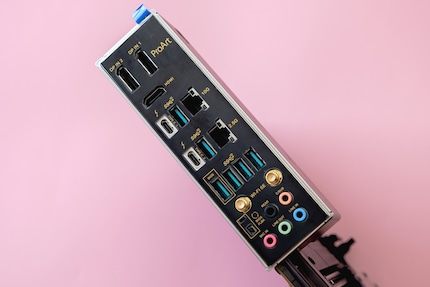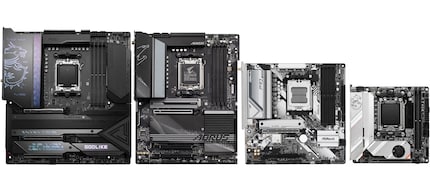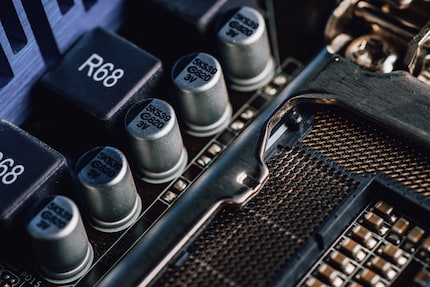
Guide
Mainboard naming explained
by Kevin Hofer

Putting together a new PC, but don’t know what to prioritise regarding the motherboard? Worry not, here are the most important points you should pay attention to.
The motherboard is probably the most overlooked PC component. Graphics cards and CPUs are more relevant to most. A shame, as motherboards are the backbone of any PC. So don’t just go for the cheap option! Here are six points you should pay particular attention to.
Note: this guide is aimed at beginners or people who haven’t assembled a PC in a while. That’s why you won’t find a deep dive here, just the most important information.
Sounds simple, but this is often ignored: you have to match your motherboard to your CPU. If you buy a high-end CPU such as a Core 9 or Ryzen 9, it makes sense to combine it with a high-end board. Accordingly, you should use a mid-range board for Core 5, Core 7, Ryzen 5 and Ryzen 7 processors. Only with Core 3, Ryzen 3 or even weaker processors should you go for a budget board.
In a following article, I’ll summarise what distinguishes high-end, mid-range and entry-level boards. However, much will also become clearer by reading the other points.
Even in 2023, not every motherboard will have Wi-Fi or Bluetooth. If these features are important to you, you should make sure your motherboard supports them. You can retrofit it using a PCIe plug-in card or USB receiver, but then you’ll occupy the corresponding slot on the board.

The rear ports are something else you should keep in mind. High-end boards offer more connections with newer standards. The USB and/or Thunderbolt ports are likely to be particularly important. Just because a board offers many of these connections doesn’t make it good. Cheaper motherboards often rely on older standards such as USB 2.0. As a result, you should pay attention to the port’s standard too.
Also not to be forgotten are the internal connections, i.e. those on the motherboard that you can’t reach from the outside. Even today, many motherboards still don’t offer a USB-C connection on the housing. Things like SATA ports can also be important if you still want to install HDDs or SATA SSDs. You’ll also need enough on-board connections for the fans, depending on your build, including a potential pump connection for water cooling.
You can usually tell apart a high-end from a low-end board by the standards used. Still, you have to be careful. Motherboard manufacturers have room to play, for example when it comes to RAM. For example, the Gigabyte Z790 Aourus Elite AX supports up to four DDR5-7600 modules. The Asrock Z790 Taichi also accepts four sticks, but «only» up to DDR5-7200.
Another point is the PCIe standard. Both motherboards mentioned support PCIe 5.0, but only in the PCI Express x16 slot. The M.2 slots for SSDs only offer PCIe 4.0. The Asus ROG Maximus Z790 Herohas one, for example, but only with an additional plug-in card. As you can see, just because manufacturers advertise PCIe 5.0, doesn’t necessarily mean it’ll apply to all components.
Aside from the PCIe standard, the number of slots is also important – even if many things such as sound or network cards are on-board today. The form factor is decisive here. The most common are as follows (in ascending order of size):
Mini-ITX motherboards, for example, only offer one PCIe slot and only two RAM slots. microATX and ATX offer space for four RAM slots and more PCIe components. You can install up to eight RAM sticks on E-ATX boards. And PCIe also offers even more, of course.

You’ll also have to pay attention to housing compatibility here. Not every ATX case is compatible with E-ATX. And combining a huge tower with a Mini-ITX motherboard is unlikely to make sense.
Voltage regulator modules (VRM) supply your CPU with the correct voltage. Every motherboard has VRM, otherwise your CPU would burn out. At 12 volts, the voltage of your power supply unit is far higher than that of the CPU. That’s usually between 1.1 and 1.3 volts – and only in rare cases at 1.5 volts.
Motherboards don’t only have one VRM, but several. The term phases is relevant here. Why? Well, regulating voltage generates heat. Thanks to several phases, the current is distributed over a larger physical area, reducing heat generation. Heat sinks that dissipate heat are also important here.

As a rule of thumb, it’s therefore better if a motherboard has more phases. The number of phases should also correlate with the selected CPU. If you’re installing a Core 9 or Ryzen 9, the motherboard should have more phases than for a Core 5 or Ryzen 5. And if you want to overclock your CPU, having many phases is even more important. You can assume that high-end boards have more phases than cheaper ones. The cheapest Z790 board for Intel processors has ten phases, the most expensive 26.
Of course, the quality and design of the installed components also play a role. Here too, you can assume that the higher a motherboard is in the product portfolio, the better the components installed. If you want to be absolutely sure, best check the specifications of the voltage transformers in the manual.
Most extra features for motherboards are cosmetic. This can be a screen that shows BIOS codes or even system information such as the temperature and clock frequency of the CPU. Configurable RGB LEDs are also a common addition to more expensive motherboards.
Some models also deliver more in terms of cooling. The Aqua series from Asrock, for example, comes with a monoblock. This allows both the CPU and the voltage converters to be cooled with water.
Other features include a BIOS flash button and USB port, which can be used to update the BIOS without a CPU. Speaking of BIOS: manufacturers usually place more value on sophisticated setting options in the BIOS of more expensive boards, benefitting power users and overclockers.
In summary, a motherboard should never be the weakest component of your system. Instead of buying a graphics card with factory overclocking, it’s better to get the standard version and invest the money in a better motherboard. Nothing is more annoying than not having the necessary ports.
Cover picture: tinhkhuong
From big data to big brother, Cyborgs to Sci-Fi. All aspects of technology and society fascinate me.
Practical solutions for everyday problems with technology, household hacks and much more.
Show all